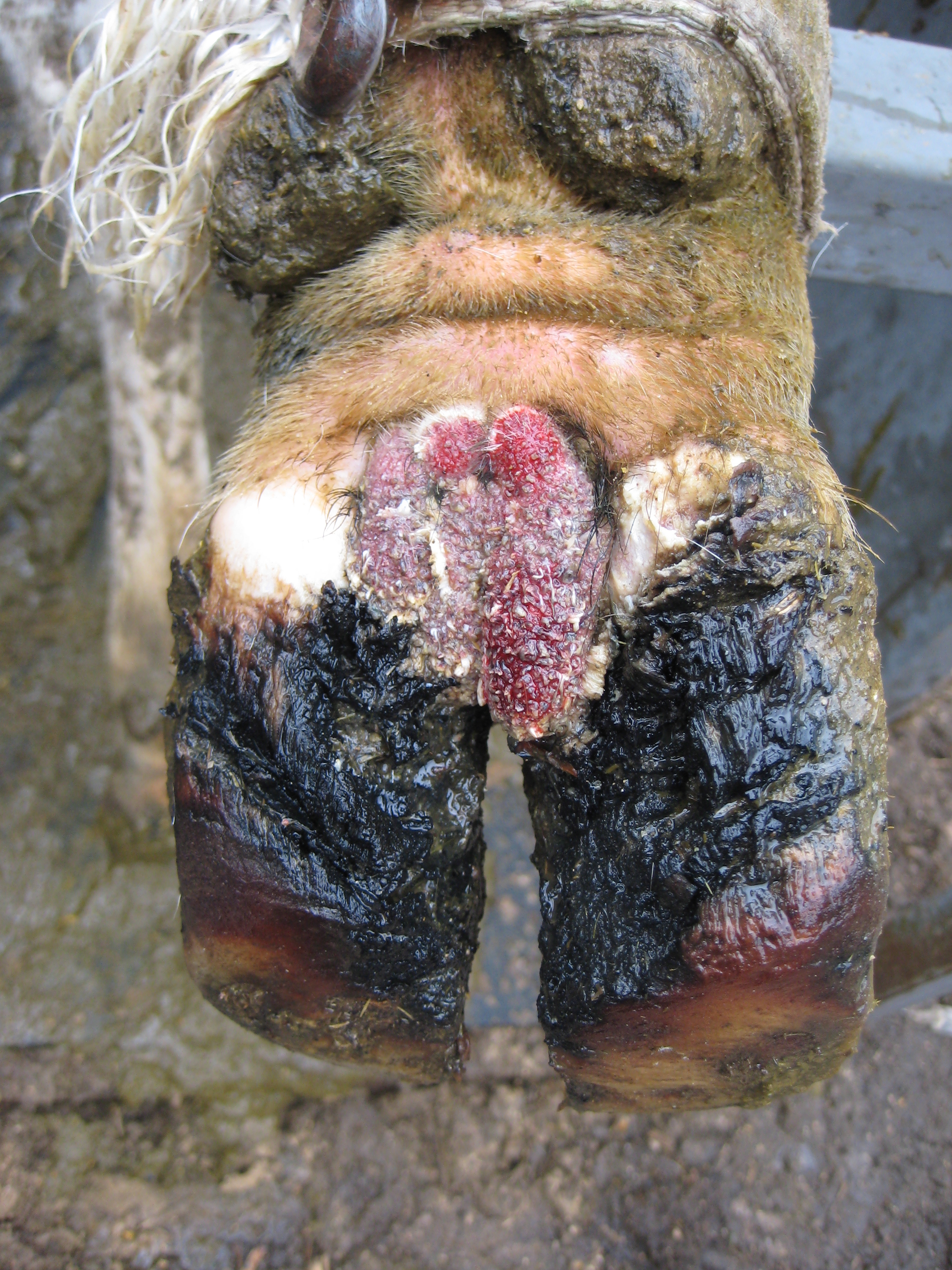



Don’t Be Fixated on Active Lesions Alone, Epidemiologist Warns
GLOBAL - Controlling bovine digital dermatitis (DD) may require increased attention to focus on preparturition heifer stages, as early as the calf and beyond acute cases in lactating cows.According to an epidemiologist at Wisconsin University, disease prevalence can be reduced by including youngstock within long term, integrated dermatitis prevention and control programmes.
These programmes are aimed at the early detection of active DD lesions, their prompt topical treatment, mitigation of risk factors, recording of claw lesions, regular professional hoof trimming sessions and foot baths customized to the dynamics of DD on each farm.
All combine to reach the so-called “Manageable State of Disease”.
Studies have found that treponemes, the bacteria associated with causing DD, can go dormant deep in the skin, meaning foot bath and antimicrobial topical treatments are evaded.
Essentially, this means that conventional control methods are contributing to the formation of disease reservoirs in the chronic stages of DD.
This is according to Dr. Dörte Döpfer, a specialist in veterinary epidemiology at the University of Wisconsin.

She has suggested that treponemes can emerge after a potentially lengthy dormant stage to result in recurrent active DD lesions.
“Basically, by exposing the cows to foot baths and topical treatments in excessive frequency and concentrations at acute active and chronic stages of this endemic claw disease, we are provoking our own reservoirs of disease,” said Dr Döpfer. “Many people are not aware of this.”
“What happens is a morphological change of the treponemes which invades in a corkscrew shaped, spiral form, passing into the epidermis and dermis,” she explained. “These changes are provoked by chemical changes such as antimicrobial and chemical impacts, and changes in pH.”
Following the invasion, the treponemes are in the dermis before going dormant. What follows are proliferations of the epithelium, or hairy heel warts.
Dr Döpfer’s theory is that a dormant stage lasts until there is an impact from a risk factor, such as poor hygiene, at which point the treponemes emerge, resulting in new lesions.
This could go towards explaining recurrence of the disease and periodic outbreaks of DD during certain seasons.
Projects have shown DD prevention in pre-calving heifers results in significantly fewer cases in lactating cows.

The solution, according to Dr Döpfer, is to extend an integrated prevention and control system to early stages of heifer rearing and to prevent chronic stages of DD from recurring by best-practices for footbaths and mitigation of risk factors.
“Currently we are not paying enough attention to pre-calving heifers,” added Dr Döpfer. “These animals are key to preventing digital dermatitis during lactation and preventing chronic stages of disease.”
She added that this is pertinent to farms where heifers are reared on a separate unit and then introduced into the lactating herd post parturition, a common arrangement in the US.
Dr Döpfer said: "It is very likely that the cross-infection of youngstock from the lactating cows in smaller herds is happening at a very young age."
These heifers will often have proliferations or ulcers and then carry the disease into the herd, where the condition recurs in 75 per cent of cases.
“If a heifer has acquired digital dermatitis during pre-calving, digital dermatitis is more prone to reoccur during lactation. An uninfected animal is far less likely to develop digital dermatitis during lactation.” Dr Döpfer summarised.
She added: “Only one per cent of cows that have not had digital dermatitis before calving, end up with digital dermatitis when in the milking herd.”
Dr Döpfer would like to see this knowledge spread more widely and for it to be utilised in future control.
Her key message is that, for the time being, digital dermatitis is ‘here to stay’ and it is well established across the major dairy industries of the world.
Around 95 per cent of herds have digital dermatitis in the US and, according to Dr Döpfer, infection varies from 20-30 per cent of the herd to as high as 95 per cent in new outbreaks.
This is cause for concern for farmers, who feel let down by claw health managers when the problem is not eliminated.
But Dr Döpfer explained the implication of the research accordingly: “If you are lifting a foot to treat an active acute stage of DD, you are too late because the treponeme has already descended into the dermis and epidermis and formed a reservoir of disease.”
*
"If you are lifting a foot to treat an active acute stage of DD, you are too late"
Therefore, long term control prevention is important, because of the difficulty to heal lesions once infected. The chronic DD lesions are particularly difficult to eliminate.
Widespread cases are now reported in England and Tim Carter, Chairman of the National Association of Cattle Foot Trimmers (NACFT), agrees that there is no easy solution.
“The best bet is to control it once is gets on your farm, as there aren’t many farms in the UK without digital dermatitis now,” said Mr Carter.
The NACFT is responsible for assessing foot trimmers and ensuring hoofcare is undertaken hygienically, to the highest professional standards made possible on each farm.
Based in Dorset, in the south west of the UK, Mr Carter has seen the problem of non-healing lesions exacerbate over the past year.
“This is where lesions don’t heal because digital dermatitis has got into the lesion,” he explained.
“Once bacteria get inside, it is terrible to try and get the lesion to heal. Like toe necrosis, there is limited success at healing wounds, some say they manage it but there are plenty of trimmers not that fortunate.”
Mr Carter agreed that plans should be tailor made for each individual farm with regards to foot baths, although he said that, as an industry, foot trimmers like to stay away from the specifics of products and chemistry.
Dr Döpfer stressed the issue of chemicals can be a tricky one. Cooper sulphate impacts the environment and formaledyde has implications for farm worker health, she explained.
She outlined the attributes of a suitable hoof bath, currently being investigated by Wisconsin University colleagues.
“A good hoof bath design allows cattle to move swiftly through a long hoof bath so to avoid defecation and ensure each foot is dipped twice.” Information about the “Ideal Hoofbath” as recommended by Dr Nigel Cook from UW-Madison can be found under: http://www.vetmed.wisc.edu/dms/fapm/fapmtools/lameness.htm
She also warned that seasonal flare ups are common, and understanding this is important to limiting conditions which prompt outbreaks.
In Wisconsin, this can vary across the year. Peaks are typically seen in early fall and late winter, sometimes followed by an early summer flare up, she added.
Stockmen Should Remember
- To prevent active stages of digital dermatitis – by that point it is too late
- Detect acute active DD lesions early and treat promptly
- DD is a chronic disease with long-term consequences – this needs a shift in awareness
- That this is a condition driven by chronic stages, not the active stage alone
- To form an integrated prevention and control system that reaches a manageable state of disease, including heifer and calf management.
Michael Priestley
News Team - Editor
Mainly production and market stories on ruminants sector. Works closely with sustainability consultants at FAI Farms



